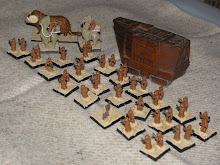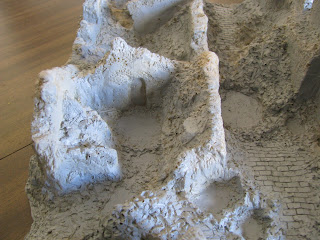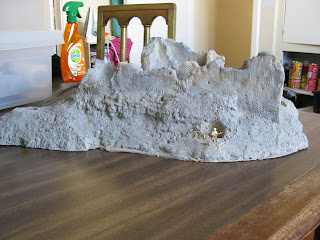About ten years ago I ran a large WW1 game called a 'Trench too Far'. the game was set on the western front in around 1917 and had around 3-4 players a side. The venue was the University of Canterbury Students' Association's boardroom, which had a huge boardroom table which was perfect for running large games on. Of course a big WW1 game needs lots of trenches. So I had to figure out a simple way of building trenches that would be easy to make, easy to store, easy to transport, and able to be reconfigured for other games. Fortunately, my good friend Adrian had previously made some trenches based on the instructions in the GDW Book 'The Soldier's Companion' - which is the miniatures rules system for Space 1889. Naturally, I adapted this idea, and Adrian's well crafted trenches, into something that could be mass produced by undergraduates.
 |
| The trench box, with 20mm Italeri (Esci reissue) US Vietnam War Infantryman for scale. |
 |
| The lid is removed. |
 |
| Standard trench section. |
 |
| Cross section view. |
Essentially, the basic design was to make a standard footprint of cardboard, run two sections of 20mm high cardboard, 22-25mm apart, down the middle of the section, and put foam, plaster,or other material, on either side to build up the trench sides. While a wider trench footprint would have allowed for a much gentler slope and looked much better, storing and moving them would have been a hassle. A larger footprint would have been more difficult to deploy on the tabletop in large numbers. given these factors, and the need to churn them out in numbers, compromises in realism were made to increase playability.
 |
| Angled sections created kinks and zags in the line. |
 |
| Cross section of a late production trench. |
Towards the end of the production run angled cardboard was used to build up the trench sides.
 |
| Top of a T section, to allow communication trenches between trench lines. |
The sections were sprayed before flocking, some with base back, others with base brown, with generally another coat of brown sprayed over top. My plan is to refurbish these sometime this year, by respraying and flocking, and adding in some duckboards and other bits to each trench. I might even get organised and put an inventory label on the box. I am rather fond of these trenches, and have used them as a teaching aid, when teaching Year 10s about Trench Warfare. At the same time I built up sections of barbed wire and I will put up pictures of that at some stage.






















































